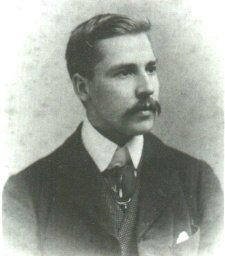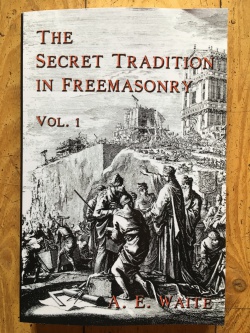En:Arthur Edward Waite: Unterschied zwischen den Versionen
K |
K |
||
| (Eine dazwischenliegende Version desselben Benutzers wird nicht angezeigt) | |||
| Zeile 1: | Zeile 1: | ||
| + | |||
| + | [[Datei:ArthurEdwardWaite1880.JPG|250px|right|thumb|Arthur Edward Waite]] | ||
| + | |||
| + | [[Datei:Waite.jpg|250px|right]] | ||
| + | |||
== Arthur Edward Waite == | == Arthur Edward Waite == | ||
| − | Source: http://en.wikipedia.org/wiki/Arthur_Edward_Waite | + | '''Source: http://en.wikipedia.org/wiki/Arthur_Edward_Waite''' |
| − | |||
Arthur Edward Waite (October 2, 1857 – May 19, 1942) was a scholarly mystic who wrote extensively on occult and esoteric matters, and was the co-creator of the Rider-Waite Tarot deck. As his biographer, R.A. Gilbert described him, "Waite's name has survived because he was the first to attempt a systematic study of the history of western occultism — viewed as a spiritual tradition rather than as aspects of proto-science or as the pathology of religion." | Arthur Edward Waite (October 2, 1857 – May 19, 1942) was a scholarly mystic who wrote extensively on occult and esoteric matters, and was the co-creator of the Rider-Waite Tarot deck. As his biographer, R.A. Gilbert described him, "Waite's name has survived because he was the first to attempt a systematic study of the history of western occultism — viewed as a spiritual tradition rather than as aspects of proto-science or as the pathology of religion." | ||
| Zeile 31: | Zeile 35: | ||
*Waite, Arthur Edward, ''Theories As to the Authorship of the Rosicrucian Manifestoes'', Whitefish, MT:Kessinger Publishing, 2005. ISBN 1425332900. | *Waite, Arthur Edward, ''Theories As to the Authorship of the Rosicrucian Manifestoes'', Whitefish, MT:Kessinger Publishing, 2005. ISBN 1425332900. | ||
*Waite, Arthur Edward, ''The Hidden Church of the Holy Grail: Its Legends and Symbolism Considered in Their Affinity with Certain Mysteries of Initiation and Other Traces of a Secret Tradition in Christian Times'', Amsterdam, the Netherlands:Fredonia Books, 2002. ISBN 1589639057. | *Waite, Arthur Edward, ''The Hidden Church of the Holy Grail: Its Legends and Symbolism Considered in Their Affinity with Certain Mysteries of Initiation and Other Traces of a Secret Tradition in Christian Times'', Amsterdam, the Netherlands:Fredonia Books, 2002. ISBN 1589639057. | ||
| + | |||
| + | ==Links== | ||
| + | *Wikipedia http://en.wikipedia.org/wiki/Arthur_Edward_Waite | ||
{{Languages|Arthur Edward Waite|Deutsch}} | {{Languages|Arthur Edward Waite|Deutsch}} | ||
| − | [[Kategorie:Personalities | + | {{SORTIERUNG:Waite}} |
| + | [[Kategorie:Personalities]] | ||
Aktuelle Version vom 1. Februar 2019, 18:54 Uhr
Inhaltsverzeichnis
Arthur Edward Waite
Source: http://en.wikipedia.org/wiki/Arthur_Edward_Waite
Arthur Edward Waite (October 2, 1857 – May 19, 1942) was a scholarly mystic who wrote extensively on occult and esoteric matters, and was the co-creator of the Rider-Waite Tarot deck. As his biographer, R.A. Gilbert described him, "Waite's name has survived because he was the first to attempt a systematic study of the history of western occultism — viewed as a spiritual tradition rather than as aspects of proto-science or as the pathology of religion."
Early life
Waite was born in the United States. Waite's father, Capt. Charles F. Waite, died when he was at a very young age, and his widowed mother, Emma Lovell, returned to her home country of England, where he was then raised. As they were not well off, Waite was educated at a small private school in North London. When he was thirteen, he was then educated at St. Charles' College. When he left school to become a clerk he wrote verse in his spare time. The death of his sister, Frederika Waite, in 1874 soon attracted him into psychical research. At twenty-one he began to read regularly in the Library of the British Museum, studying many branches of esotericism.
When Waite was almost thirty years old, he married Ada Lakeman (also called 'Lucasta') and they had one daughter, Sybil Waite. Some time after Lucasta's death in 1924, Waite married Mary Broadbent Schofield. He spent most of his life in or near London, connected to various publishing houses, and editing a magazine The Unknown World.
A.E. Waite joined the Hermetic Order of the Golden Dawn in January 1891 after being introduced by E.W. Berridge. He became a Freemason in 1901, and entered the Societas Rosicruciana in Anglia in 1902. The Golden Dawn was torn by further internal feuding until Waite's departure in 1914; later he formed the Fellowship of the Rosy Cross, not to be confused with the Societas Rosicruciana. By that time there existed some half-dozen offshoots from the original Golden Dawn, and as a whole it never recovered.
Aleister Crowley, foe of Waite, referred to him as a villainous Arthwate in his novel Moonchild and referred to him in his magazine Equinox. Lovecraft has a villainous wizard in his short story "The Thing on the Doorstep" called Ephraim Waite; according to Robert M. Price this character was based on Waite.
Author and scholar
Waite was a prolific author with many of his works being well received in academic circles. He wrote occult texts on subjects including divination, esotericism, Rosicrucianism, Freemasonry, and ceremonial magic, Kabbalism and alchemy; he also translated and reissued several important mystical and alchemical works. His works on the Holy Grail, influenced by his friendship with Arthur Machen, were particularly notable. A number of his volumes remain in print, The Book of Ceremonial Magic (1911), The Holy Kabbalah (1929), A New Encyclopedia of Freemasonry (1921), and his edited translation of Eliphas Levi's Transcendental Magic, its Doctrine and Ritual (1896) having seen reprints in recent years.
Tarot deck
Waite is best known as the co-creator of the popular and widely used Rider-Waite Tarot deck and author of its companion volume, the Key to the Tarot, republished in expanded form the following year, 1911, as the Pictorial Key to the Tarot, a guide to Tarot reading. The Rider-Waite-Smith Tarot was notable for being one of the first tarot decks to illustrate all 78 cards fully, in addition to the 22 major arcana cards. Golden Dawn member Pamela Colman Smith illustrated the cards for Waite, and the deck was first published in 1909.
Other works
- Waite, Edward, Inner and Outer Order Initiations of the Holy Order of the Golden Dawn, Canada:Burnaby, 2005. ISBN 0-9735931-7-2.
- Waite, Arthur Edward, Israfel: Letters, Visions and Poems, London:Allen, 1886.
- Waite, Arthur Edward, A New Encyclopaedia of Freemasonry (Ars Magna Latomorum) and of Cognate Instituted Mysteries: Their Rites, Literature, and History, New York:Wings Books, 1994. ISBN 0517191482.
- Waite, Arthur Edward, Theories As to the Authorship of the Rosicrucian Manifestoes, Whitefish, MT:Kessinger Publishing, 2005. ISBN 1425332900.
- Waite, Arthur Edward, The Hidden Church of the Holy Grail: Its Legends and Symbolism Considered in Their Affinity with Certain Mysteries of Initiation and Other Traces of a Secret Tradition in Christian Times, Amsterdam, the Netherlands:Fredonia Books, 2002. ISBN 1589639057.
Links


